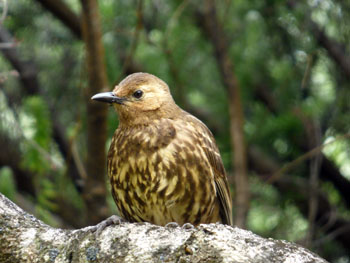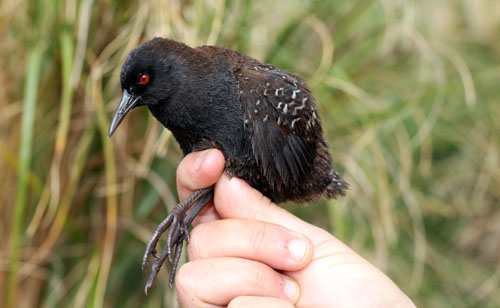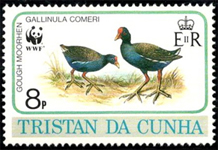There are seven land birds that are endemic to the Tristan group. All except the Starchy are vulnerable or endangered. At least two more species went extinct on the main Tristan island in the 19th century.
Tristan Thrush or Starchy

The Tristan Thrush or Starchy (Turdus eremita) is endemic to Tristan da Cunha, Nightingale and Inaccessible Islands.
Three sub-species can be recognised partly by size on the three islands (populations surveyed 2007):
- The Tristan Turdus eremita eremita (50 pairs) is smaller and duller than both the -
- Nightingale Starchy Turdus eremita procax (400 pairs) which is slightly larger and more richly-coloured than -
- The Inaccessible Starchy Turdus eremita gordoni (850 pairs).
They occur in all habitats on Nightingale and Inaccessible, but are generally restricted to the mountain Base and gulches on Tristan, having been greatly reduced by predation by rats, and historically by cats.
Starchies are omnivorous and can eat just about anything given the opportunity - invertebrates, seeds, berries, and carrion, e.g. from skua kills. They can break open eggs with their bills and the tongue has a fringed edge adapted for licking up egg contents. They have even been seen to feed on intertidal crustaceans and stranded jellyfish.
They breed September-December, later higher up, nesting in thick vegetation, and laying 2-3 eggs. Chicks fledge after 20 days, staying with adults for 3-4 weeks, when they are fed mainly on earthworms and Empetrum or Island Berries.
The species' original scientific name was Nesocichla eremita, but genetic studies show that they evolved from a Turdus thrush vagrant from South America. The former genus name Nesocichla has therefore been re-classified to Turdus
Starchies are the only native land bird to survive on the main island of Tristan. The moorhen and bunting that were once endemic to Tristan went extinct in the 19th century.
Inaccessible Rail

The Inaccessible Island Rail (Atlantisia rogersi), which is only found on Inaccessible Island is the world's smallest flightless bird. It has soft fluffy plumage, a slender bill, and a bright red eye. They occupy all habitats, but especially marshy areas. The rails creep through dense cover, dashing across openings rather like a mouse, and also like a mouse use favoured runways. They breed October-January, nesting in balls of woven grasses with a short entrace tunnel. They mostly eat invertebrates and earthworms, but also eat seeds and berries.
Recent DNA studies have shown that the rail's ancestors originally came from South America.
See more at: Origin of the world's smallest flightless bird solved.
Moorhens

The Gough Moorhen or Island Cock (Gallinula comeri) is also flightless. The bird has sooty grey or brown plumage with white flanks, mostly red legs, and a distinctive yellow-tipped red bill with a red frontal shield. They remain in dense cover, but sometimes climb the larger branches of Phylica trees and enter seabird burrows. They breed September-February, laying 2 to 5 eggs in cup-shaped nests. Their diet is mainly invertebrates, seeds and other plant material.
Some Gough Moorhens were released on Tristan island at Sandy Point by the Gough Island Scientific Survey (GISS) of 1955/56, and they are now common on the island, especially the eastern mountain Base, cliffs and at Sandy Point. In the past, Tristan island had its own Tristan Moorhen (Gallinula nesiotis), but this became extinct in the 19th century. It was once thought the some of these may have persisted among the Gough Moorhens, but recent DNA studies have shown this not to be the case.
Finches or Buntings
Tristan's finches traditionally were called buntings, given their resemblance to the European buntings that were familiar to Tristan's early naturalist explorers. However, we now know that they are derived from South American finch-tanagers. The yellow birds are also known locally as canaries. The finches on the main island group all belong to the genus Nezospiza

There are two finch species on Nightingale Island. The Nightingale Finch (Nezospiza questi) is a small billed bird that forages for seeds, berries and invertebrates. Wilkins' Finch (Nezospiza wilkinsi) on the other hand has a heavy bill specialised to crack open the fruits of Phylica trees.
Inaccessible Island is home to three subspecies of Nezospiza acunhae with different but overlapping habitats. The large billed Dunn's Finch (N. a. dunnei), like Wilkins' Finch, lives in Phylica woodland. As its name suggests, the Upland Inaccessible Finch (N. a. fraseri) populates the island's plateau, whereas the Lowland Inaccessible Finch (N. a. acunhae) lines in the Spartina tussock grass.
Finches also used to be found on the main Tristan island, but they had died out by the 1860s, probably due to the introduction of rodents and cats.
The Gough Finch (Rowettia goughensis) derives from a different lineage of Patagonian finches, and therefore has its own genus. It is found in all habitats on Gough Island.
See also the 2014 Tristan's Endemic Finches stamp issue.
